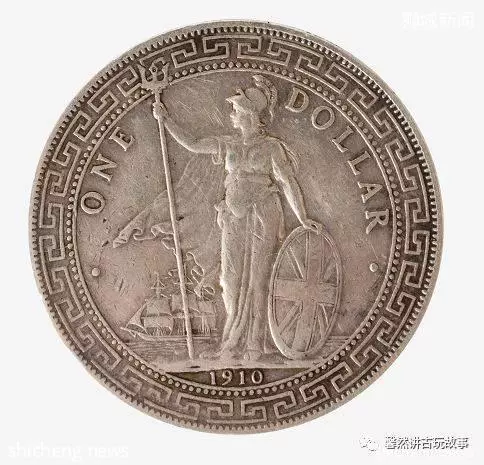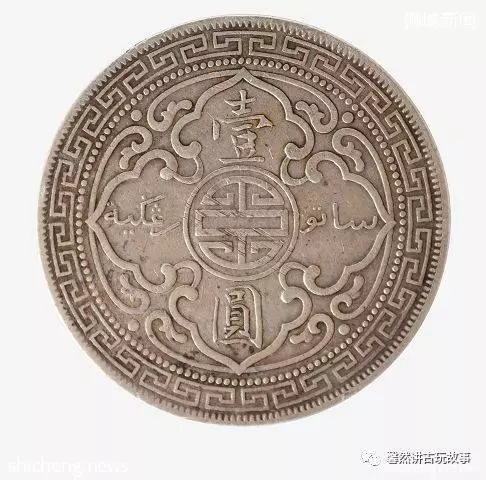19世紀末,帝國主義列強掀起了瓜分中國的狂潮。清政府腐敗無能,無法抵禦外敵侵略,先後與外國列強簽訂了一系列不平等條約,使中國淪為半封建半殖民地社會。外國列強為了在華爭奪利益,幾十個國家的銀元先後湧入中國,通過不公平貿易,換取我國大量白銀。
At the end of the 19th century, the imperialist powers set off a frenzy to divide China. The Qing government was corrupt and incompetent and could not resist the invasion of foreign enemies. It successively signed a series of unequal treaties with foreign powers, making China a semi-feudal and semi-colonial society. In order to compete for interests in China, foreign powers have poured silver coins from dozens of countries into China in order to exchange unfair trade for a large amount of silver in China.

【英國站洋幣正面】
1895年,英國政府利用印度的孟買,加爾各答的造幣廠鑄造了新的貿易銀元,俗稱「站人」。「站人」銀元先後在英國倫敦、印度孟買和加爾各答等兩國三地製造,「站人」銀元進入我國後,開始在廣東、廣西一帶流通,因其製作精美,含銀量高,深得商民喜愛。英國政府看到「站人」銀元在中國有利可圖,便大量鑄造,大量輸入。不久,「站人」銀元便在中國大部分地區使用,尤以北京,天津為盛。當時,在中國流通的外國貨幣中,「站人」銀元已占相當大比例,使中國白銀源源不斷的流入英國,經貿利益受到嚴重損害。由於當時香港並未發行過壹圓銀幣,且該幣在香港一度獲得法定流通資格,因此廣東部分地區也習慣稱為「香港壹圓」。
[British station foreign currency front]
In 1895, the British government used Mumbai, India, and Calcutta's mint to cast a new trade silver dollar, commonly known as the "station man." The "station man" silver dollar was successively manufactured in London, England, Mumbai, India, and Calcutta. After the "station man" silver dollar entered China, it began to circulate in Guangdong and Guangxi. Because of its exquisite production and high silver content, it was deeply loved by businessmen. The British government saw that the "standing person" silver dollar was profitable in China, and it was cast in large quantities and imported in large quantities. Soon, the "station person" silver dollar was used in most parts of China, especially Beijing and Tianjin. At that time, among the foreign currencies in circulation in China, "standing people" silver dollars had accounted for a considerable proportion, causing the continuous flow of Chinese silver into the United Kingdom, and the economic and trade interests were seriously damaged. Since Hong Kong did not issue a round of silver coins at that time, and the currency was once legally eligible for circulation in Hong Kong, some parts of Guangdong are also used to being called "Hong Kong yen."

[英國站洋幣 背面]
藏品名稱:1910年版站洋幣
重:26.8g
直徑:3.9cm
British station foreign currency back
Collection name: 1911 edition foreign currency
Weight: 26.8 g
Diameter: 3.9 cm
站洋的不同版別多寡數量極其不均,個別稀少年號、稀少暗記是名副其實的珍品,如1911、1921、1934等年號極少,1904、1913、1925、1929、1930等年號也屬稀少品,其它年號則見仁見智,說法不一了。此件站洋幣系1911年版,銀幣正面是一名武士左手持米字盾牌,右手執三叉戟,意為能攻能守,戰無不勝。背面中心為壽字紋,上下為中文「壹圓」,左右為馬來文「壹圓」。此組站洋幣圖案精美,內涵深邃,且存世極少,實為難得,具有很高的收藏價值及增值空間。
The number of different versions of the station ocean is extremely uneven. Individual rare teenagers and rare hidden records are veritable treasures. For example, 1911, 1921, 1934 and other years are very few, 1904, 1913, 1925, 1929, 1930 and other years are also rare. product, Other years are different from each other. This station is a 1911 edition of the foreign currency system. On the front of the silver coin, a samurai holds a rice shield in his left hand and a Trident in his right hand, which means that he can attack and defend. The center of the back is the longevity pattern, the upper and lower Chinese "round", and the left and right Malay "round". This set of foreign currency design is exquisite, profound, and very few exist. It is really rare and has a high collection value and value-added space.
「站人」銀元集英文、中文、馬來文等三國文字於一體,這在世界鑄幣史上是非常罕見的。特別是將中國古老的篆字記於外幣之上,令人啼笑皆非。它不僅反映了一段扭曲的歷史,而且反映了英國及其英殖民地國家,一個特殊時期的政治、經濟、文化、書法的發展變化。所以,「站人」遠遠超過一個國家,一種銀幣的文物價值。就中國而言,「站人」銀元作為一種歷史載體,記錄了鴉片戰爭以後,中國人民政治上受壓迫,經濟上受剝削的屈辱歷史。研究在中國流通的外國貨幣,對於我們了解外國列強利用銀元貿易,掠奪中國財富的罪行,增強愛國主義精神,為中華民族的偉大復興貢獻力量,具有十分重要的意義。故收藏之不僅是因其投資價值也因其所蘊含的歷史文化價值。
"Station Man" silver yuan is a collection of three languages: English, Chinese, and Malay. This is very rare in the history of world coinage. In particular, it is ironic to record ancient Chinese seal characters on foreign currencies. It not only reflects a distorted history, but also reflects the political, economic, cultural, and calligraphy changes in the United Kingdom and its colonial countries. Therefore, the "standing man" far exceeds a country, the cultural value of a silver coin. As far as China is concerned, "standing man" silver yuan, as a historical carrier, records the history of the humiliation of the Chinese people's political oppression and economic exploitation after the opium war. It is of great significance for us to study the foreign currencies circulating in China to understand the crimes of foreign powers using silver dollar trade to plunder Chinese wealth, strengthen patriotism and contribute to the great rejuvenation of the Chinese nation. Therefore, the collection is not only because of its investment value but also because of its historical and cultural values.
























